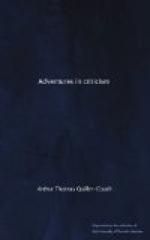Let it be understood, of course, that it is only your Solveigs and Mrs. Lindens who can thus save a brother’s soul: women who have made their own way in the world, thinking for themselves, working for themselves, freed from the conventions which man would impose on them. I know Mr. Archer will not retort on me with Nora, who leaves her husband and children, and claims that her first duty is to herself. Nora is just the woman who cannot redeem a man. Her Doll’s House training is the very opposite of Solveig’s and Mrs. Linden’s. She is a silly girl brought up amid conventions, and awakened, by one blow, to the responsibilities of life. That she should at once know the right course to take would be incredible in real life, and impossible in a play the action of which has been evolved as inevitably as real life. Many critics have supposed Ibsen to commend Nora’s conduct in the last act of the play. He neither sanctions nor condemns. But he does contrast her in the play with Mrs. Linden, and I do not think that contrast can be too carefully studied.
MR. SWINBURNE’S LATER MANNER
May 5, 1894. Aloofness of Mr. Swinburne’s Muse.
There was a time—let us say, in the early seventies—when many young men tried to write like Mr. Swinburne. Remarkably small success waited on their efforts. Still their numbers and their youth and (for a while also) their persistency seemed to promise a new school of poesy, with Mr. Swinburne for its head and great exemplar: exemplar rather than head, for Mr. Swinburne’s attitude amid all this devotion was rather that of the god than of the priest. He sang, and left the worshippers to work up their own enthusiasm. And to this attitude he has been constant. Unstinting, and occasionally unmeasured, in praise and dispraise of other men, he has allowed his own reputation the noble liberty to look after itself. Nothing, for instance, could have been finer than the careless, almost disdainful, dignity of his bearing in the months that followed Tennyson’s death. The cats were out upon the tiles, then, and his was the luminous, expressive silence of a sphere. One felt, “whether he received it or no, here is the man who can wear the crown.”
And Her Tendency towards Abstractions.
It was not, however, the aloofness of Mr. Swinburne’s bearing that checked the formation of a Swinburnian school of poetry. The cause lay deeper, and has come more and more into the light in the course of Mr. Swinburne’s poetic development—let me say, his thoroughly normal development. We can see now that from the first such a school, such a successful following, was an impossibility. The fact is that Mr. Swinburne has not only genius, but an extremely rare and individual genius. The germ of this individuality may be found, easily enough, in “Atalanta” and the Ballads; but it luxuriates in his later poems and throughout them—flower and leaf and stem. It was hardly more natural in 1870 to confess the magic of the great chorus, “Before the beginning of years,” or of “Dolores,” than to embark upon the vain adventure of imitating them. I cannot imagine a youth in all Great Britain so green or unknowing as to attempt an imitation of “A Nympholept,” perhaps the finest poem in the volume before me.




